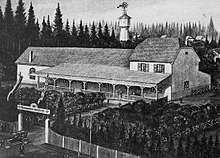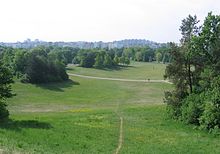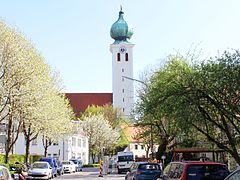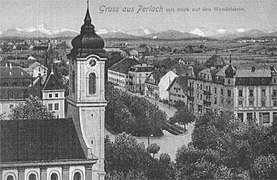Ramersdorf-Perlach
|
Ramersdorf-Perlach
State capital Munich
Coordinates: 48 ° 6 ′ 10 ″ N , 11 ° 37 ′ 30 ″ E
|
|
|---|---|
| Area : | 19.9 km² |
| Residents : | 117,918 (Dec. 31, 2019) |
| Population density : | 5,927 inhabitants / km² |
| Postcodes : | 81539, 81549, 81669, 81671, 81735, 81737, 81739 |
| Area code : | 089 |
|
Location of the city district 16 Ramersdorf-Perlach in Munich
|
|
Ramersdorf-Perlach is the district 16 of the Bavarian capital Munich .
It consists of the two former communities Ramersdorf (incorporated on January 1, 1864) and Perlach (incorporated on January 1, 1930) as well as the two districts of Waldperlach and Neuperlach, which are located in the former municipality of Perlach . The former districts of Michaeliburg and Fasangarten in Perlach are now largely part of the Trudering-Riem and Obergiesing-Fasangarten districts .
In the city district there are eleven primary schools, three secondary schools, two special schools, four secondary schools, two grammar schools, one orientation level, two vocational schools, 43 kindergartens, nine day nurseries, 21 day nurseries, two day care centers, eight leisure homes, 72 parks and green areas (151 hectares), 44 playgrounds, four district sports facilities, two district libraries, an indoor and outdoor pool. As part of the urban area alignment of the Munich Adult Education Center , a branch of the Munich Adult Education Center was set up in Neuperlach-Süd. The University of Television and Film was located on the border of the district of Giesing until 2011. There are 75 stops operated by the Münchner Verkehrsgesellschaft (including five stops for the underground and two for the S-Bahn within the city, as well as three underground and two S -Broad stations at the city district boundaries, plus eleven bus or tram lines). The district committee consists of 45 members.
Ramersdorf
Rumoltesdorf was first mentioned in a document in the years 1006 to 1022 in a Freising document copy. However, the ending "-dorf" indicates that a settlement could have existed as early as the second half of the 9th century, especially since individual members of the Rumoltes family have been documented since the 8th century. From the 13th to the 16th century, various ministerial families and patrician families are named as owners of the farms; some of these properties were also given to the Church as endowments until they returned to secular ownership during the secularization of 1803. From 1818 until it was incorporated into Munich in 1864, Ramersdorf was a separate municipality. A far-reaching redesign of the district came about during the reign of National Socialism through the large-scale road construction and with the model settlement Ramersdorf .
The pilgrimage church of Maria Ramersdorf marks the old town center, which is now quite wedged between the middle ring and the entrance to the Munich-Salzburg motorway . The Ramersdorf Church has been documented since the beginning of the 11th century, and alongside Altötting it is probably one of the oldest pilgrimage sites in Bavaria . The pilgrimages to the image of Mary may have started at the beginning of the 14th century, in this century a cross particle also came into the possession of the church. The church was rebuilt in the 15th and 16th centuries and extensive baroque renovations took place in the 17th century . The current tower dates from the end of the 18th century. At the beginning of the 19th century, many votive tablets and other representations that paid homage to an exuberant cult of saints were broken off "in the name of the Enlightenment". After founding a separate parish in 1907 ( Maria Ramersdorf was up until then a branch church of St. Michael Perlach) extensive restorations were undertaken, which at the same time led to the discovery of older parts of the church, e.g. from the Gothic period .
Appreciation: "Both the traditions of building and pilgrimage history as well as the high -quality furnishings, including the preciously set cross particles and the Ramersdorf image of grace and, last but not least, the late Gothic carved altar attributed to Erasmus Grasser , demonstrate the high art and cultural historical importance of the Ramersdorf church." (Karin Hösch)
Due to the number of documents, several district initiatives and organizations decided in 2005 to hold Ramersdorf's millennium in 2006.
Balanstrasse West
West of Ramersdorf or Altperlach is the district part Balanstraße West, which is also called Ramersdorf-Süd or Nussdorf. However, none of these names are very common. This part of the district is bounded in the west and south by the route of the S-Bahn line to Kreuzstrasse. The MVG Museum of the Münchner Verkehrsgesellschaft is located in Ständerstraße .
Perlach
First documented mention around 790 as peralohc (pera = boar, loh = light forest). The old town center, the former Unterdorf , which was able to retain its village character in the core, is the Pfanzeltplatz, through which the Hachinger Bach flows, with the baroque parish church of St. Michael (built since 1728 in place of a Romanesque previous building). In the former upper village to the south, the Evangelical Church of St. Paul has been standing since 1848 , today the oldest preserved Protestant church in Munich.
Before the establishment of the independent community in 1818, Perlach was divided among various landlords: the bishops of Freising , the monasteries of Tegernsee and Schäftlarn , and from the 13th century the Bavarian dukes also had holdings here . Between 1686 and 1790, four properties in Perlach were elevated to noble seats, so-called court brands , and given lower jurisdiction :
- Perlachwart (Ottobrunner Strasse 142/144, broken off in 1967)
- Perlachort (Schmidbauerstraße, part of the Perlach district clinic)
- Perlachsoed ( Perlachsoed Castle , Fasangartenstrasse 3)
In 1697, the builder of Perlachsoed Palace was Johann Sebald Neusönner , governor of Elector Max Emmanuel of Bavaria
- Perlacheck (Putzbrunner Strasse 3)
The Hofmark Perlachseck was the stay of the physicist Carl August von Steinheil .
The districts of Michaeliburg (today part of the city district 15 Trudering-Riem ) and Fasangarten (today part of the city district 17 Obergiesing ) developed in the Perlach municipality in the 20th century . Plans for a garden town of Perlach , projected to the southwest of the old town in the Perlacher Forest and presented by Art Nouveau architect Hans Eduard von Berlepsch-Valendas in 1910, were not implemented. On the former Perlacher Haid , east of Perlach, the Neuperlach district emerged from 1967 . On January 1, 1930 Perlach was incorporated into Munich.
Pheasant garden
The name comes from a former forester's house near Perlach, to which a pheasant farm was affiliated from the beginning of the 18th century until 1805. In the 1920s, an initially wild settlement emerged here, which was relocated to Munich on October 1, 1937. The majority of Fasangarten is now part of Munich's district 17 ( Obergiesing ).
Michaeliburg
The Michaeliburg is named after the first settler, Michael Obermeyer, whose inn built in 1898 had a castle-like character due to its tower, but it has been demolished since summer 2009. The settlement that emerged here at the beginning of the 20th century was partly on Perlacher, partly on Truderinger municipality and was incorporated into Munich on January 1, 1930 and April 1, 1932, respectively. The majority of Michaeliburg is now part of Munich's district 15 ( Trudering-Riem ).
Waldperlach
Around the built in 1910 and inaugurated in June 1911 forest or Leiberheim the members of the infantry regiment body created in 1911 a settlement. As early as 1912, its residents tried to get the place name Wald-Perlach , but a corresponding application was unanimously rejected by the Perlach local council in 1920. It was not until 1928 that the Bavarian Ministry of the Interior approved the new name for the forest colony, which at that time already had around 700 inhabitants. Waldperlach has a primary school (Gänselieselschule, inaugurated in May 1952), a Catholic church ( St. Brother Klaus ), a Protestant church (Jubilate Church, the water tower built by the settlers during World War I was converted into a bell tower), a volunteer fire brigade (new building of the fire station in 2006) and two sports clubs, the SV Waldperlach (SVW) and the EC Waldperlach (ECW). The cabaret artist and actor Dieter Hildebrandt lived in the suburb of Waldperlach .
Neuperlach
To alleviate the housing shortage that faced the city of Munich, which was growing rapidly in the 1950s, the Munich city council decided in 1960 to establish relief cities , the first of which should be built in the Perlach area and offer living space for 80,000 residents. With (today) around 55,000 inhabitants, Neuperlach is the largest West German satellite town . Its first three construction phases (north, northeast, east) were realized in quick succession after the laying of the foundation stone in May 1967; the center was largely built between 1974 and 1978. The central square is still a torso today. The south section followed from 1980 to 1991.
East Park
The Ostpark is a park in the northwest of the Neuperlach district. In 1969, construction began on an initial section of 15.75 hectares, which was completed in 1975. In 1979 the second section was opened to the public, and in 1982 the Ostpark officially opened with its entire area of 56 hectares. The Ostpark borders on the Michaelibad in the north .
Architectural monuments
- List of architectural monuments in Munich / Perlach
- List of architectural monuments in Munich / Ramersdorf
politics
The Ramersdorf-Perlach district committee was last elected on March 15, 2020. The distribution of seats in the election on March 15, 2020 was as follows: CSU 14, Greens 13, SPD 12, FW / ÖDP 3, FDP 1, DIE LINKE 1 and AfD 1. Of the 76,965 residents in Ramersdorf-Perlach who are entitled to vote, 32,748 have exercised their right to vote, which means that the turnout was 42.5 percent.
In the 2018 state election , the members of the constituency of Munich-Ramersdorf were elected to parliament : Markus Blume (CSU), Susanne Kurz (Greens) and Markus Rinderspacher (SPD).
statistics

(As of December 31, residents with main residence)
| year | Residents | including foreigners | Inhabitants per km² |
|---|---|---|---|
| 2000 | 100.002 | 25,607 (25.6%) | 5,027 |
| 2001 | 100,387 | 25,868 (25.8%) | 5,046 |
| 2002 | 100.129 | 25,939 (25.9%) | 5,033 |
| 2003 | 100,724 | 26,330 (26.1%) | 5,062 |
| 2004 | 100,845 | 26,613 (26.4%) | 5,068 |
| 2005 | 100,820 | 27,367 (26.9%) | 5,067 |
| 2006 | 102,689 | 27,689 (27.0%) | 5,160 |
| 2007 | 103,447 | 28,005 (27.1%) | 5,198 |
| 2008 | 104,089 | 28,602 (27.5%) | 5,232 |
| 2009 | 103.732 | 28,340 (27.3%) | 5,214 |
| 2010 | 104,737 | 29,308 (28.0%) | 5,264 |
| 2011 | 105,900 | 30,494 (28.8%) | 5,323 |
| 2012 | 107.164 | 31,778 (29.7%) | 5,386 |
| 2013 | 108,244 | 32,946 (30.4%) | 5,441 |
| 2014 | 110,099 | 34,699 (31.5%) | 5,534 |
| 2015 | 112,371 | 36,798 (32.7%) | 5,648 |
| 2016 | 113,898 | 38,102 (33.5%) | 5,725 |
| 2017 | 114,478 | 38,097 (33.3%) | 5,754 |
| 2018 | 116,327 | 39,425 (33.9%) | 5,847 |
| 2019 | 117,918 | 40,543 (34.4%) | 5,927 |
Source with further data
people
- Karl Maria Harrer , Catholic priest and writer (born November 9, 1926 in Ruhpolding ; † June 17, 2013 in Altötting ) was pastor in Waldperlach from 1963 to 1996.
- Judith Williams (* 1971), German-American entrepreneur, television presenter and opera singer, was born here.
gallery
Ramersdorf town center with St. Maria Church
Perlach: Protestant St. Paulus Church ( Georg Friedrich Ziebland 1849)
literature
- Ramersdorf and Perlach
- Franz Kerscher, Wolfgang Läpke (program workshop in the Kulturhaus Ramersdorf-Perlach, ed.): Art in Perlach . Munich 2005 ( interactive version of the brochure in HTML format ).
- Leonhard Wagner: Ramersdorf, Perlach and the new bells. A rural cultural image from the Munich area from 1881 . Perlach 1916 (52 pages).
- Ramersdorf
- Karlheinz Hemmeter: The “Ramersdorf-Dorfkern” ensemble. Thoughts on physiognomy, historical statements and integration in the big city as well as current urban planning changes . In: Contributions to local research. Wilhelm Neu on his 70th birthday (workbooks Bavarian State Office for Monument Preservation , No. 54). Munich 1991, pp. 74-86.
- Ursula Henn: The Ramersdorf model estate in Munich: A settlement concept between tradition and modernity . Munich 1987 (Miscellanea Bavarica Monacensia, 138 / Neue Schriftenreihe des Stadtarchiv München, 432 pages).
- Karin Hösch, Gregor Peda: Parish and pilgrimage church Maria Ramersdorf - Munich . Passau 1996, ISBN 3-89643-033-5 (40 pages).
- Axel Jost (Ramersdorf Festival Committee): 125 years of Ramersdorf near Munich . Munich 1989 (155 pages).
- Franz Kerscher (program workshop in the Kulturhaus Ramersdorf-Perlach, ed.): Hidden cultural assets. 1000 years of Ramersdorf . Munich 2006 (94 pages).
- Hanns Vogel ( City of Munich / Department of Culture ): 1864-1964. Ramersdorf 100 years near Munich . Official commemorative publication. Ottobrunn 1964 (136 pages).
- Working group district history Ramersdorf eV : Ramersdorfer Gschichten 1 to 7 (illustrated series with stories from Ramersdorf).
- Perlach
- Geographical Institute of the Technical University of Munich (Hrsg.): Village structures on the outskirts. A social science analysis of the old part of Perlach . Munich 1968 (Contributions to Urban Development, No. 2).
- Adolf Hackenberg: Perlach in the 20th century: history and stories. 30 years of the Perlach community, 25 years of the Munich-Perlach district . Munich 1996 (128 pages).
- Georg Mooseder, Adolf Hackenberg (ed.): 1200 years of Perlach: 790–1990. Origin and development history of a Munich district with the districts Perlach, Fasangarten, Michaeliburg, Waldperlach and Neuperlach . 2 volumes, Munich 1990/1992 (volume 1: 956 pages, volume 2: 336 pages).
- Georg Mooseder, Lothar Altmann: Catholic parish church St. Michael Perlach . Regensburg (24 pages).
- Hans Eduard von Berlepsch-Valendàs: The garden city of Munich-Perlach . Munich 1910 (96 pages).
- Neuperlach
- Petra Dorsch: A new home in Perlach. Settling in as a communication process . Diss. Univ. München, Munich 1972 (198 pages).
- Christian Hartard: Neuperlach. Utopia of the urban. Concepts and cityscapes from an experiment in the 1960s . Mag.-Work. Univ. München, Munich 2003 (145 pages, full text ).
- Christian Hartard: Come on, let's build a city. How the dream of the urban failed in the 1960s due to the decay of public space. Some remarks on the outskirts from Munich-Neuperlach. In: Mitteilungen der Geographische Gesellschaft in München , 88, 2006 ( full text ).
- New home Bavaria (ed.): Relief city Perlach in Munich . Munich 1967 (92 pages).
- See for further references:
- Helmut Stahleder: From Allach to Zamilapark. Names and basic historical data on the history of Munich and its incorporated suburbs . Munich 2001.
- Christian Hartard: Neuperlach. Utopia of the Urban ( full text ).
Web links
- Ramersdorf district - state capital Munich
- District Perlach - State Capital Munich
- City District and District Committee 16 Ramersdorf-Perlach - City of Munich
Individual evidence
- ↑ Statistical Pocket Book 2020 (PDF). Statistical Office of the State Capital Munich. Retrieved August 24, 2020.
- ^ Wilhelm Volkert (ed.): Handbook of Bavarian offices, communities and courts 1799–1980 . CH Beck, Munich 1983, ISBN 3-406-09669-7 , p. 601 .
- ↑ District Committee 16 - Ramersdorf / Perlach: Balanstrasse West
- ↑ Research on the Gänselieselschule ( memento of the original from March 4, 2016 in the Internet Archive ) Info: The archive link was inserted automatically and has not yet been checked. Please check the original and archive link according to the instructions and then remove this notice. (PDF file; 3.75 MB)
- ↑ a b c Election of the District Committee - District 16 - Ramersdorf-Perlach . State capital Munich. Retrieved June 10, 2020.
- ^ Archive district information . State capital Munich. Retrieved January 6, 2019.





















